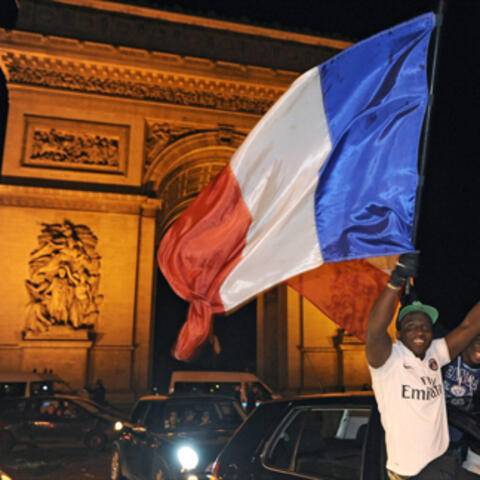An artist from Texas is helping one of France’s most stigmatised housing estates to revamp its image thanks to innovative art projects, which introduce teenagers to flesh-eating plants and rappers to Baroque choruses.

“I’ve always believed that the best way for people to take an interest in you is to be interested in others,” says American artist Monte Laster.
He lives and works in an old windmill in the heart of one of France’s most notorious housing estates, La Cité des 4,000 in the northern Paris suburb of La Courneuve.
He works with the local community via the French-American Cultural Exchange (Face) organisation.
Every Friday Laster heads along to Joliot-Curie Elementary School on the multi-ethnic housing estate to conduct a workshop with five- and six-year-olds.
They’re sitting on a Morroccan carpet around a low table and each takes turns inventing fairy tales using the word “Balzac” while another films with a small camera.
Balzac, as in Honoré de, the French writer, yes. But also as in the name of a huge social housing block looming over their school.

Balzac is due to be demolished this summer, just like Debussy, Renoir, Ravel and Présov before it, as part of a lengthy urban renewal programme.
Laster says that, while many local residents are happy to see the building go, it’s still a big deal and there’s little assistance to residents, especially for the kids.
“If the building’s being destroyed,” says Laster, “it’s not because it’s impossible to renovate, but because there’s a strong negative identity.”
Balzac’s been described as a supermarket for drugs. It’s had its fair share of gang violence and murder.
In June 2005 an 11-year-old boy was shot dead while cleaning a car just in front of it. Nicolas Sarkozy, who was then an interior minister preparing to run for president, famously came and said he would clean up the scum with a power hose.
That power hose will now be a bulldozer. The last family has left and the demolition will begin this summer.
Laster is also helping the kids to look beyond their immediate surroundings, teaching them English as part of an exchange programme with Thurgood Marshall Academy in Harlem, NY.
Jean-Pierre Bastion, one of the teachers who grew up on the estate and is committed to staying here, appreciates Laster’s approach, talking about destruction at a time when the kids are building their characters.
“They need to build themselves despite the negative image in the media. When you see your town stigmatised by the media it’s difficult to be motivated. [He’s] building citizens who learn to love life and love to study.”
Laster’s workshops with the kids are part of a long-term project called OBA (Our Better Angels). The title comes from a reference US President Barack Obama made in his inaugural speech, quoting Abraham Lincoln.
“The idea was to find the better angels of our nature, to show respect for all people, and what’s best in mankind. It’s also a bit provocative, the whole idea of calling kids from this neighbourhood the best of our angels,” Laster says.
He doesn’t deny the area has there are problems, but prefers to work with its bad-boy image, use the energy, and build on it.
Previous projects have brought together teenagers and carnivorous plants, local rappers and Baroque Venetian choruses. Another brought back a little train that used to run in the neighbourhood and encouraged local people to talk about the cycle of life.
“It’s about trying to create ways for people to see their own neighbourhood with totally different eyes, and then it’s the reaction to all that, filmed and photographed and archived,” Laster says. “So it’s also a way of archiving the transformation of this whole area that’s so symbolic for France.”
Last year, as part of OBA 1, Laster took a group of young local rappers and bloggers to the US. They gave concerts in Harlem and Washington, met producers, had recording sessions, were even welcomed at the White House, missing Obama by just a few minutes.
They then made a film out of their experience, a kind of road movie.
Performing in front of 40 ambassadors in Washington was awesome, says local rapper Flex.
“There we were in our jeans, they were in suits, but they smiled at us. Thanks to Monte, there was respect […] That trip helped us show people we could be serious, could work hard. People back here are now taking more of an interest in us.”
Laster is now working on the follow-up, OBA 2, where Harlem will come to La Courneuve.
Guests will include Abiodun Oyewole, founder of the US group The Last Poets founded in Harlem in 1968, and arguably of rap itself.
It’s hoped he’ll be putting La Courneuve under the microscope, looking at how rap has taken hold there, exploring how we can reconnect rap with its origins in revolution and social rights, far from gangsta violence.
OBA 2 will also involve projects with the local prison and the Louvre museum around the question of what a masterpiece is.
Long-term, the results of OBA are to be exhibited via photography, film, music, written works and artistic installations in Paris and New York.
“It’s very exciting,” says Laster, “I hope we can find the financing, the means to be able to take it to the level it really has the potential to be.”
Daily newsletterReceive essential international news every morning
Subscribe